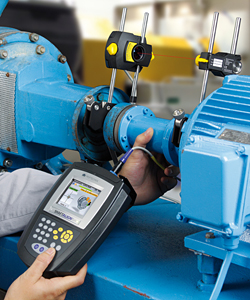Every asset-intensive organization understands that the greater the uptime of machines, the more efficient and cost-effective operations will be. Keeping your assets in optimal working order is easier and more cost-efficient when advanced technology such as laser shaft alignment is used to increase machine reliability.
The Machine Maintenance Goal
One of the goals of every production-oriented operation is to keep its machines operating at the lowest cost yet highest productivity levels. In order to do so, proper maintenance must be performed on machines. The level of maintenance care of machines can be broken down into four major categories:
- Purely reactive or run to failure
- Basic preventive maintenance and inspections
- Combination of predictive maintenance methodologies and preventive maintenance
- Organizations making use of preventive and predictive maintenance as well as advanced technologies such as laser shaft alignment, vibration analysis, infrared thermography, etc.
At the heart of most good maintenance operations is a CMMS system that records and tracks all asset detail and maintenance work information. The premise of a CMMS is that the more asset and historical work information you have, the more efficient and effective your maintenance planning will be.
Why Shaft Alignment Technology is Necessary?
A natural extension to using a CMMS is the use of advanced shaft alignment technology because it adds valuable information regarding the condition of the machines that might otherwise go undetected until machine failure occurs.
Typical signs of misalignment include:
- Abnormally hot components, the smell of burning insulation
- Bearing issues or grinding noises
- Higher energy usage
- Load imbalances
- Rotor bar problems
- Excessive vibration
One proven method for machinery alignment is laser shaft alignment. With up to 50% of damage to rotating machinery directly related to misalignment, correcting this problem in machines is critical to production as well as operating budgets. But these are not the only reasons:
Top 7 Reasons to use Laser Shaft Alignment
Laser shaft alignment can lower your operating costs through:
- Early identification of problems enables machine maintenance to be proactive.
- Reduced maintenance cost as a result of sharp reductions in bearing, seal, shaft, and coupling failures.
- Reduced vibration lengthens the useful lifecycle of the machine as well as increases the quality of output.
- Less unplanned downtime so production can be optimized.
- Fewer emergency repairs lowering labor costs.
- Error-free and accurate measurements to 0.0001″.
- Reduced energy consumption. Poorly aligned machines require more energy to achieve the same results as a well-aligned asset.
Who Can Benefit from Laser Shaft Alignment
Laser shaft alignment can be used in any industry ranging from manufacturing to the wind power industry that depends on machinery to function. Machinery alignment is a cost-effective solution whenever critical functions are at risk. Some examples include, but are not limited to:
- Processing and centrifugal pumps used by the petrochemical industry
- Boiler feed pumps are found in every power plant and also in general industry
- Vertical turbine pumps found at water treatment plants
- Refrigeration compressors used for food processing and cold storage
 Protecting your machines through precision shaft alignment is not an option, it is a must in today’s competitive environment. Old dial indicator technology may have too low a resolution to measure accurately enough and are subject to reading errors and hysteresis or sticking dial hands. On the other hand, laser shaft alignment is error-free with reports generated directly from the instrument in conformity with ISO 9001 requirements.
Protecting your machines through precision shaft alignment is not an option, it is a must in today’s competitive environment. Old dial indicator technology may have too low a resolution to measure accurately enough and are subject to reading errors and hysteresis or sticking dial hands. On the other hand, laser shaft alignment is error-free with reports generated directly from the instrument in conformity with ISO 9001 requirements.
“7 Reasons Why Machines Need Laser Shaft Alignment” was written for us by Stuart Smith, MBA, MS. He is an avid writer about CMMS and EAM software solutions for Mintek Mobile Data Solutions. Stuart has over 25 years of experience running operations in multiple industries.
Filed under:
Alignment, Articles and Case Studies by Ana Maria Delgado, CRL
